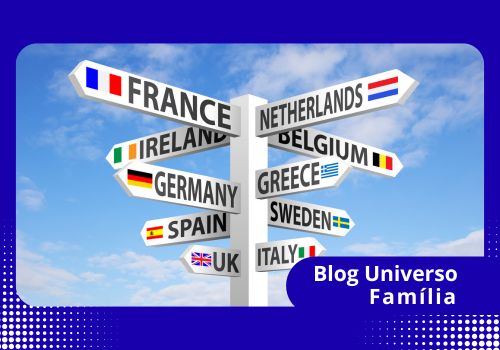Ads
Traveling to Europe: Budget-Friendly Destinations You Should Consider may seem like an unattainable dream, but in 2025, the reality is different.

With low-cost airlines, price-comparison platforms, and a wide range of alternative accommodations, discovering the Old Continent without spending a fortune is entirely possible.
In this article you will find a practical guide to the most accessible countries, tips for saving and an updated price comparison that will allow you to plan your European adventure with financial intelligence and without sacrificing experiences.
Why Europe remains the favorite destination
Europe is home to some of the most visited destinations on the planet. In 2024, according to data from the World Tourism Organization (UNWTO), the continent received more than 700 million international tourists, which represents about 56% of world tourism.
Its cultural diversity, its living history, and the ease of travel between countries thanks to the Schengen Area make it an incomparable region.
Ads
But, beyond the historical charm of Paris or Rome, more and more travelers are looking for less expensive alternatives, places where you can enjoy art, food, and nature without breaking the bank.
And that raises the question: what are the most affordable European destinations in 2025?
1. Portugal: the perfect balance between quality and price
Portugal has established itself as one of the most profitable destinations in Western Europe.
Its capital, Lisbon, combines modernity with tradition, but prices remain much lower than in other European capitals.
A lunch at a local restaurant can cost less than 10 euros, and accommodations in central areas are still around 30 to 50 euros per night.
In addition, public transport is efficient and accessible.
Outside the capital, cities like Porto or Braga They offer even more economy and an authentic atmosphere.
Its wine, Atlantic coast, and hospitality make Portugal an accessible gem for those who want to experience Europe without spending too much.
2. Hungary: Imperial culture at fair prices
Budapest is a clear example of how Traveling to Europe: Budget-Friendly Destinations You Should Consider It can be a luxury experience without the price tag.
The city is famous for its thermal baths, monumental architecture, and lively nightlife.
Compared to the European average, Hungary maintains a cost of living 40% lower, making it an excellent choice for students, backpackers, or families looking for a balance between convenience and savings.
In addition, national and regional trains make it easy to travel around the country with reduced fares. It's the kind of destination where every euro goes twice as far.
3. Poland: history, nature and savings
Krakow, Gdansk, and Warsaw stand out among the most affordable European destinations. Poland combines history and culture with affordable cuisine and hotels.
A concrete example: a coffee in Krakow costs on average 1.50 euros, and entrance fees to museums or historic castles rarely exceed 5 euros.
But what surprises travelers most is the quality of its infrastructure and the warmth of its people, making Poland not just an economical option, but an emotionally rich experience.
4. Greece: Mediterranean beauty at reasonable prices
While some Greek destinations are synonymous with luxury, there are islands and regions where the experience is both accessible and fascinating.
Naxos, Paros or Crete They are more affordable options than Santorini or Mykonos, but just as charming.
Inter-island ferry tickets have dropped by up to 20% in the last two years, according to the Greek maritime authority, making it easier to explore the archipelago without great expense.
If you plan ahead, you can enjoy a seaside dinner for less than 15 euros and stay in charming family-run accommodations.
5. Czech Republic: art and beer at a good price
Prague remains a must-see destination. Its historic center, castle, and cobblestone streets make it a living postcard.
But beyond its beauty, the city offers moderate prices for budget-conscious travelers.
An analogy sums it up well: Traveling to Prague is like enjoying Paris, but paying half the price..
The quality of service, its public transportation network, and the safety of its surroundings make it ideal for both solo and couple travelers.
Comparative table of average costs per day (2025)
| Country / City | Accommodation (€) | Food (€) | Transport (€) | Estimated daily total (€) |
|---|---|---|---|---|
| Lisbon, Portugal | 40 | 15 | 5 | 60 |
| Budapest, Hungary | 35 | 12 | 4 | 51 |
| Krakow, Poland | 30 | 10 | 3 | 43 |
| Athens, Greece | 45 | 18 | 6 | 69 |
| Prague, Czech Republic | 38 | 14 | 5 | 57 |
Source: Eurostat, Tourism Cost Report 2025.

Read more: 10 tips for stress-free travel with children
Tips for traveling cheaply in Europe
- Travel during the low season. The months of March, April, October, and November offer the best prices and fewer crowds.
- Use regional trains and low-cost buses. Companies like FlixBus and RegioJet connect dozens of cities at reduced prices.
- Opt for alternative accommodations. Platforms like Couchsurfing or Airbnb remain safe and affordable options.
- Compare flights in advance. Skyscanner or Google Flights allow you to detect real trends and promotions.
- Get a card with no international fees. This prevents surprises in your expenses and improves currency conversion.
Two real examples of smart travel
- Andrea and Luis, a Mexican couple, toured Portugal and Spain for 20 days, spending less than 2,000 euros in total thanks to a combination of low-cost flights, regional trains, and local cuisine.
- ElenaA university student, she spent a month in Poland and Hungary staying in hostels and using shared transportation. On a limited budget, she managed to visit six cities and return with unforgettable memories.
Both cases show that the key factor is not money, but smart planning.
The impact of responsible and local tourism
Traveling on a budget doesn't mean neglecting your social or environmental impact.
Supporting local businesses, avoiding mass tourism, and respecting each country's customs are ways to travel ethically.
Every choice, from where to eat to where to stay, contributes to the sustainable development of European communities.
Additionally, cities that promote more balanced tourism, such as Ljubljana or Tallinn, offer incentives and discounts for those who choose eco-friendly options.
A trend that will undoubtedly shape the future of tourism in Europe.
Conclusion: traveling cheap is also traveling better
Traveling to Europe is no longer synonymous with exclusive luxury.
Today, with planning and judgment, you can enjoy authentic experiences, ancient culture, and unforgettable landscapes without breaking the bank.
Let us remember that Traveling to Europe: Budget-Friendly Destinations You Should Consider It's not just a search for savings, but an opportunity to discover authentic places, connect with real people, and appreciate simplicity.
Because, in the end, what most enriches a trip is not how much you spend, but how much you learn from the path.
Read more: The best family destinations for 2025
Frequently asked questions about cheap travel to Europe
1. What is the best month to find cheap flights to Europe?
The lowest fares usually appear between February and April. Booking at least three months in advance can reduce the cost to as little as 30%.
2. How much does it cost to travel around Europe for a month on a budget?
It depends on the travel style, but an average budget is around 1,500 and 2,000 euros, including lodging, transportation and food.
3. Can you travel with a backpack and work in Europe?
Yes. Some countries offer temporary work visas or volunteer programs with accommodation included, ideal for those looking to extend their stay.
4. Which European countries readily accept cashless payments?
Virtually all, but the most advanced in digital payments are Netherlands, Sweden, Finland and Germany, although they also accept cash without any problem.
In summary, the secret to Traveling to Europe: Budget-Friendly Destinations You Should Consider It's in planning, flexibility and curiosity.
Each city is an open door to European history, gastronomy, and hospitality, proving that luxury isn't always about the price, but about the experience.